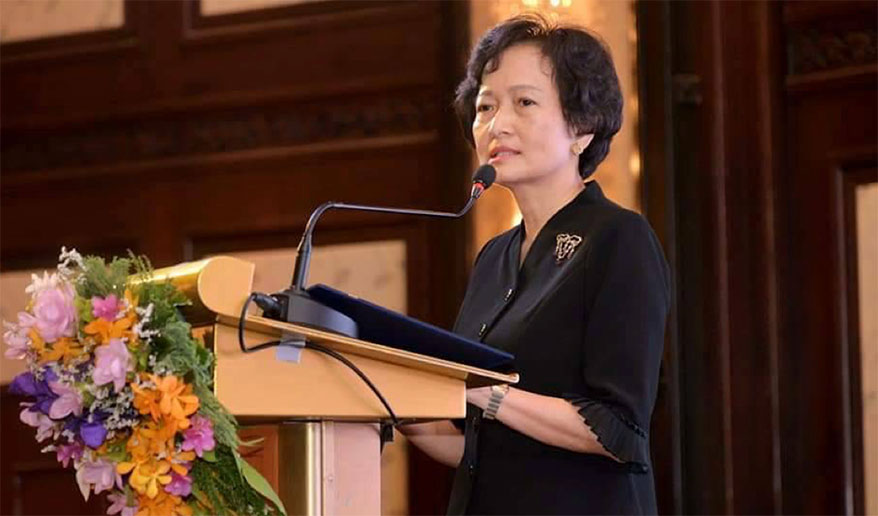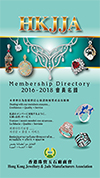(PRESS RELEASE) Nuntawan Sakuntanaga speaks to Isabella Yan about her career achievements, challenges, her vision for the Thai gems and jewelry industry, as well as the Gem and Jewelry Institute of Thailand’s (GIT) biggest agenda for 2021.
Sakuntanaga started working in Thailand’s Ministry of Commerce in 1983 and was the permanent secretary of the Ministry until she retired in 2018. Most of her career was in trade promotion and public policy, acquiring unparalleled experience in almost every department.
Soon after her retirement, she was nominated to become president of the GIT. Presently, she’s a board member of the Securities and Exchange Commission, PTT public company Ltd. and other government and non-profit organizations.
1. Can you walk us through your main career achievements and did you envisage achieving so much when you started?
During my time in the Department of International Trade Promotion (DITP), a lot of work was done to promote the gems and jewelry industry. Thirty five years ago, Thailand exported only around US$300 million USD of gems and jewelry but we saw the potential because Thailand has multiple gem sources. More importantly, we have centuries old cultural heritage in gold and silver craftsmanship and thousands of skilled gem cutters.
Around 2003 l became the Deputy Director general of the Department of Foreign Trade. Thailand and the US started negotiations on a comprehensive bilateral Free Trade Agreement in June 2004. I led the negotiation for the Textile and Trade Remedies chapters. The experience was beneficial and a few years later I became Director General of the Department of Trade Negotiation. Thailand was the Chairman of ASEAN then, so I chaired all the ASEAN senior officials meetings on trade and economic cooperation.
While I was the Director-General of the Department of International Trade Promotion (DITP) 10 years ago, e-commerce was becoming increasingly important in international and domestic trade, so in 2011 “Thaitrade.com” was established as the first official Thai online market platform to enable Thai exporters to reach their overseas clients 24/7 and we had to do a lot of convincing and training. We guaranteed the quality of every seller because they were all officially screened by the department.
ADVERTISEMENTToday the website is still known worldwide.
Another achievement I’m proud of was the launch of the “THAILAND TRUST MARK” campaign, given to quality products with social and environmental conscious production. Environmental, social and governance concerns were starting to become a deciding factor for certain consumer groups. This symbol would guarantee the products they were choosing were of trusted quality, while the production process was environmentally friendly and socially responsible.
I was also lucky to have been one of Thailand’s few Intellectual Property (IP) Commissioners working closely with WIPO (the World intellectual property organization) to improve the country’s IP systems. As Thailand grew it was, and still is, imperative to protect innovations and give creators the rights and benefits they deserve. I made the importance of IP more visible and more relevant to the public and was able to convince the government to give me more than double the number of patent and trademark examiners.
I was also the Director-General of the Department of Internal Trade, promoting local products especially agricultural products. Rice, corn, palm oil, tapioca and rubber are the 5 major crops that every government needed to look after as farmers accounted for a very large percentage of the population. Successfully passing the Trade Competition Act 2017 made it easier to protect SMEs from unfair use of power of large corporations as well as unfair trade practices.
I must say that, while challenging, it has been incredible and enjoyable working with all the different departments, getting to know the people and learning new things all the time.
2. What are your views and vision for the next five years for the gems and jewelry industry, especially from your personal point of view and position as a key policy maker?
Moreover, Thailand is the world’s third largest colored stone exporter and has also solidly held its rank as the world’s largest silver jewelry exporter.
Thailand has an advantage in it’s knowledge of colored stone enhancement – the local wisdom in heat treatment, exquisite polishing skills, and fine craftsmanship in jewelry production. The craftsmanship cannot be replaced by automated equipment or modern technologies.
Different enhancement methods used lead to different levels of gem quality. Gemstones from reputable sources, like Burmese ruby, Sri Lankan blue sapphire, Colombian emerald, are more expensive than those from other sources. These factors are related to the price of the gemstone. Thus, in-depth product details help consumers get the products that are worth their money.
The younger generations like the millennials place importance on responsibilities to the environment as well as transparency and ethics in business operations like responsible mining and conflict-free gemstones. Many jewelry brands, claiming their products are made with high senses of ethics, traceability and transparency, tend to gain popularity among this group of consumers. This trend seems to have also led to the growth of the lab-grown, synthetic gemstone market sector that also claims to be ethical and environmentally-friendly.
As a result, in order to maintain the Thai gem and jewelry industry’s competitiveness and keep businesses afloat in the long run, entrepreneurs have to increase buyers and consumers’ confidence in product quality and operate their business ethically and sustainably with responsibilities both to society and the environment.
ADVERTISEMENT3. What’s GIT’s biggest agenda and priorities for 2020-2021?
GIT’s main mission is to build confidence in Thai products, namely gemstones, precious metals and jewelry among domestic and overseas buyers through testing and issuing of quality certificates, as well as to develop and upskill personnel for the industry.
Due to Covid-19, business has slowed considerably in every sector. We will use this period to strengthen the industry’s standards and infrastructure. In order to help Thai entrepreneurs thrive in the long run during 2020-2021, we will prioritise two projects.
We will develop colored stone markets in Chanthaburi, a province well-known as a sourcing hub, to become a “Standardized Gem Marketplace” where buyers from around the world can conveniently and confidently source products. GIT has collaborated with local gem trader associations in promoting colored stone trading through product quality certificate issuance under GIT’s “Buy with Confidence” (BWC) project. Having a quality certificate attached to each product will create buyers’ confidence and help sellers trade their products more easily.
GIT recently set up GIT Gems and Precious Metals Standard in September 2020. The GIT standard aims to upgrade the gem and precious metals testing private laboratories or purchasing/QC laboratory sections in jewelry factories nationwide. But, since the standard is on a voluntary basis, GIT will initially form a group of pioneer labs and factories, and provide them both consultation and assessment until these labs reach the standard. GIT laboratory experts will regularly follow up and advise until all labs are able to sustain the standards in the long term.
4. What kind of initiatives are GIT taking to continue to grow Thailand as the gemstone capital of Asia?
Thailand has gained its competitive edge because of its local wisdom in enhancing the quality of gemstones and its skilled, value adding gem cutters. More than ten thousand skillful gemstone cutters have also created glistening sparkles to the colored stones. These two factors create high demand for Thailand’s polished gemstones.
In order to maintain our status as a world’s gemstone capital, PR & marketing activities need to be done earnestly and continuously. GIT has collaborated with alliance agencies and local entrepreneurs to promote and push Chanthaburi to fully become the “City of Gems.” We plan to organize gem and jewelry fairs in Chanthaburi annually. Trading areas will be arranged across the city, where both Thai and foreign buyers and sellers are welcomed. The fairs will be similar to the Tucson Gems Fair in the US.
5. What is your view on general trade trends and developments, given the recent situation with the US-China war and then Covid-19?
As a matter of fact, world trade had dwindled since last year due to the trade war between the US and China, the continued protests in Hong Kong and Brexit. These factors corroded confidence as well as the purchasing power of people around the world. The COVID-19 pandemic has worsened and quickened the recession. It is impossible for any country to avoid the impact. Decline in sales, halted business operations, delayed or cancelled orders are apparent in the jewelry sector too.
More synthetic gemstones have been available on the market as alternatives for consumers at almost half the price of their natural counterpart. Constantly rising gold prices have affected fine jewelry’s price per unit, while sanitation measures have disrupted international travelling and raised costs.
Business recovery could be ensured only after a vaccine is available, by the end of this year or in early 2021. I believe demand for gem and jewelry products will pick up then. An example can be seen in China. After the government declared the end of its lockdown and shops resumed their normal operation, there were long lines of Chinese shoppers in front of brand-name shops waiting to buy products including jewelry.
Consumer behaviors may move towards increasing usage of online platforms or digital platforms. So they need to be reassured of the quality, pricing and return policies. Retailers need to adapt accordingly.
The recent US’s removal of Hong Kong Special Status has caused Hong Kong to lose some benefits related to US exports. All gem and jewelry exports from Hong Kong to the US need to pay import tax at 0 to 13.5%, similarly to China. Due to Hong Kong’s lower competitiveness in product prices, other countries including Thailand can catch this opportunity in expanding their share of the US market. Hong Kong’s major gem and jewelry market is the US, with a 30% share. The volume of re-export products via Hong Kong will be lower and this will diminish the importance of Hong Kong as one of the world gem and jewelry distribution centers. Also, the gems and jewelry manufacturing base would relocate from Hong Kong and China to South East Asian countries. Thailand will be considered even more a key link for the global gems and jewelry supply chain.

Nuntawan Sakuntanaga speaks at the 17th International Colored Gemstone Association (ICA) Congress held in Bangkok, Thailand in October 2019.

Nuntawan Sakuntanaga at the 17th International Colored Gemstone Association (ICA) Congress in Bangkok, Thailand October 2019. From Left to Right: Ms Duangkamol Jiambutr, Director of GIT, Mr Weerasak Wangsuphakijkosol, Deputy Minister of Commerce, Mr Somdet Susomboon, Director General of the Department of International Trade Promotion (DITP) and Mr Phuket Khunprapakorn of former president of the Chanthaburi Gem and Jewelry Traders Association.
Source: Instore 3-2-2021
















